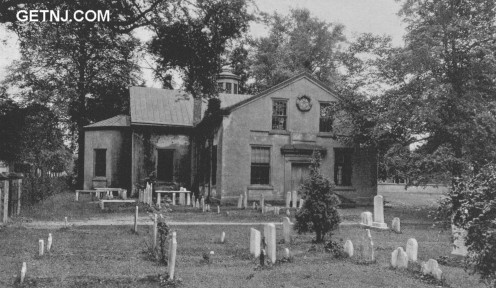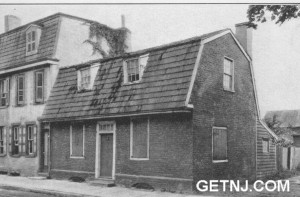Advertise Online
–
SEO - Search Engine Optimization - Search Engine Marketing - SEM
– Domains For Sale
– George Washington Bridge Bike Path and Pedestrian Walkway
– Corona Extra Beer Subliminal Advertising
– Outlaw Motorcycle Gangs
– Pet Care
–
The Tunnel Bar
–
La Cosa Nostra
–
Jersey City Free Books
From Historic Roadsides of New Jersey by The Society of Colonial Wars in the State of New Jersey, 1928
Edited by GET NJ, COPYRIGHT 2002
BURLINGTON COUNTY
 Old St. Mary's Church, Burlington
Old St. Mary's Church, Burlington
Built 1703
The boundaries of Burlington County were established in
1694, but not definitely settled until 1710, when Hunterdon
County was organized, the Assunpink Creek being then made
the boundary. In 1838 Burlington County was reduced by the
organization of Mercer County and subsequently further re,
duced by the organization of the present Ocean County.
BURLINGTON
Founded in 1677 by Friends from Yorkshire and London under "The Concessions and Agreements of
the Proprietors, Freeholders and Inhabitants of West Jersey in
America." All vessels coming to West Jersey were required
to enter and clear at the Port of Burlington. Provincial Capital,
till 1755 and again from 1757 to 1790. The Provincial Congress of New Jersey met at Burlington in 1776 and elected
the delegates to the Continental Congress who signed the
Declaration of Independence. Town occupied by British for a
few hours in December of 1776. Cannonaded by British from
River, May 1778.
|
 Revel House -- Oldest In Burlington
Revel House -- Oldest In Burlington
|
Points of interest:
- St. Mary's P. E. Church founded and building erected
1703, chartered as St. Anne's October 4, 1704. By second
charter, name was changed in 1709 to St. Mary's. Rev.
Jonathan Odell, a grandson of Jonathan Dickinson, first
President of Princeton, was Rector from 1767 to 1777. A
Tory, he was arrested by the Continentals. He was concealed for a time at home of Margaret Morris, Green Bank.
Noted for his fierce satires on America. Died in Nova
Scotia. Communion Service of Church presented by Queen
Anne.
- Graveyard of St. Mary's Church. Graves of Elias
Boudinot, first President of the American Bible Society and
William Bradford, Attorney General of the United States
under President Washington.
- 457 S. High Street. Birthplace of J. Fenimore Cooper,
1789. Now home of Burlington County Historical Society.
- 457 S. High Street. Home of Captain James Lawrence,
1781 to 1813.
- 435 S. High Street. Home of Stephen Sallet.
- High and Library Streets. Residence of Governor Bloomfield, soldier in the Revolution, Governor of New Jersey,
Mayor of Burlington, and Grand Master of the Masons.
- High Street above Broad Street. Alcazar Hotel. Residence
of Thomas Olive who arrived on Ship Kent in 1677. Act,
ing Governor of New Jersey in the absence of Samuel
Jennings.
- Blue Anchor Tavern, now Metropolitan Inn, built in 1751.
At one time meeting place of West Jersey Proprietors.
- Site of Court House, 1683. Center of Broad and High
Streets. Court removed to Mt. Holly, 1796.
- Site of Town Hall, 1794. Intersection of High and Union
Streets. Council Chambers on second floor, prison in base,
ment, whipping post in front.
- 208 High Street. Office of Samuel Jennings. First Colonial
money printed here 1726, by Benjamin Franklin.
- 222 High Street. Residence of Thomas Gardner, Land
Commissioner, built 1680. First Annual Meeting of
Friends here 1683. Friends built a meeting house, hexagonal in shape, 1683. Present meeting house constructed
- East Pearl Street. Office of Thomas Revel, Registrar of
New Jersey Proprietors, built 1685, now occupied by
Annis Stockton Chapter, D.A.R.
- Hickory Grove. Salem Road or Kings Highway, dwelling
of Samuel Smith, Historian, and Samuel J. Smith, Poet.
- Site of First School House. Northwest corner Broad and
St. Mary Streets, now occupied by St. Barnabas Church.
- Site of First House built in limits of Burlington, now farm
of Robert Sutton, River Road.
- Mantinicunk Island, once occupied by Peter Jegau, a
Dutchman. By Act of Assembly the revenue derived from
the island was devoted to maintaining public schools in
Burlington.
- Hessian Camp Ground, South High Street, occupied in
1776.
- Yorkshire Bridge, East Broad Street, over the stream which
made Burlington an island in Colonial times.
- Friends Meeting House. High Street. Organized 1678.
- Kinsey House. Home of James Kinsey, delegate to Continental Congress.
- Ferry Slip. 1713. The first steam ferry boat, 1834.
- Residence of Isaac Collins. Northeast corner York and
Broad Streets. King's printer.
- 135 W. Broad Street. Bradford House. Home of Elias
Boudinot, President of the Continental Congress, 1782,
director of Mint. Daughter married William Bradford,
Attorney General under Washington.
GREEN BANK
Residence of Governor William Franklin.
Later home of Margaret Morris who concealed Rev. Jonathan
Odell, the Tory Rector. One time residence of E. Burd Grubb.
Points of interest:
- Sycamore Tree. Green Bank. To this tree, Ship Shield,
first vessel bringing English Settlers so far up the Delaware,
tied up in 1678. Site of landing marked by tablet, erected
by Society of Colonial Wars in the State of New Jersey.
- St. Mary's Hall. Green Bank. Oldest Church School for
girls in the United States.
JACKSONVILLE
Small town outside of Burlington. Scene
of skirmish between British and American Troops. Blood stains
from wounded soldiers still shown at church.
BEVERLY. The site of Dunk's Ferry, at the foot of Laurel
Street. One detachment of Washington's Army was to have
crossed the Delaware at Beverly over Dunk's Ferry and ad
vance to Trenton from the south but was prevented from
crossing by ice in the river. During the Civil War a recruiting
camp and hospital were maintained at Beverly, and a National
Cemetery on the outskirts of the place still exists.
BORDENTOWN
Settled in 1681 by Thomas Farnsworth.
Takes its name from Joseph Borden, an early settler. In May,
1778, it was partly destroyed by the British, who had sent an
expedition to destroy the vessels in Barnes and Crosswicks
Creeks. The town is worthy of note for the names of illustrious residents, including Francis Hopkinson, J. Fenimore
Cooper, Clara Barton, Richard Watson Gilder, Patience
Wright, Admiral Charles Stewart, Joseph Bonaparte, once
King of Spain, Prince Lucien Murat, and the daughters of
Joseph Bonaparte.
Places of historical interest are:
- Clara Barton's School. Built 1739, containing her desk,
chair and pupil's chair. Building now owned and maintained by Red Cross.
- Home of Richard Watson Gilder directly opposite Barton
School, now given to Bordentown by the owner and dedicated to public use.
- Farnsworth and Park Streets. Northwest corner. Home
of Colonel Joseph Borden, son of Joseph Borden, who laid
out the town. Original house burned by the British during
the Revolution. Colonel Borden returning from the War
built house now standing, retaining original iron railing.
- Northeast corner Park and Farnsworth Streets, once the
American Hotel.
- Southwest corner. Home of Patience Wright, first American Sculptress, who, after the Revolution, went to
England.
- Southeast corner. Home of Judge Harold B. Wells, formerly home of Francis Hopkinson, Poet, Signer of the Declaration of Independence and Chairman of Committee designing American Flag. Father of Joseph Hopkinson, author
of "Hail Columbia." Francis Hopkinson was author of
"The Battle of the Kegs." Tablet erected in his memory
by Francis Hopkinson Chapter D. A. R., October 22,
1921.
- Point Breeze, Park Street. Residence of Joseph Bonaparte.
- On the River Bank, Industrial School, main building of
which was formerly home of Admiral Charles Stewart of
American Navy, grandfather of Charles Stewart Parnell.
 Crosswicks Meeting House
Crosswicks Meeting House
Bearing Marks of Cannon Shot, June 23, 1778
CROSSWICKS
Four miles east of Bordentown. Settled in
1681. Scene of a skirmish in June, 1778, between the Continental Troops and a detachment of the British Army retreating from Philadelphia to New York via Bordentown and Monmouth. The contest occurred at the bridge over Crosswicks
Creek, the Continentals endeavoring to destroy the bridge and
prevent the crossing. During the skirmish, a cannon ball fired
struck the Old Friends Meeting House at Crosswicks, which
still bears the marks of the shot, the ball being kept as a
curiosity.
MOORESTOWN
Nine miles from Mt. Holly and nine miles
from Camden. Derived its name from an early settler named
Moore and was settled at an early date. Scene of a British
encampment on the night of June 19, 1778, on land now owned
by Amos Stiles and Benjamin Warrington, about three hundred
yards from the Friends Meeting House.
Home of Commodore Truxton, distinguished American
Naval Commander, located on road from Moorestown to Mt.
Holly about one and a half miles from Moorestown.
MT. HOLLY
Settled by the Friends not long after the
settlement of Burlington, originally known as Bridgeton. Of
considerable importance in Revolutionary War. Legislature of
New Jersey held some of its meetings here and British Troops
were quartered on the inhabitants. William, Duke of Clarence,
later King William IV, was stationed there with the British
Troops in the Revolution.
Mt. Holly, home of William Denning, maker of first
wrought-iron cannon made in the world, one of which was
completed prior to Battle of the Brandywine and captured by
the British. Denning refused British offers of an annuity and
sums of money to instruct them in the manufacture of guns.
Mt. Holly was, in 1757, site of a draft for soldiers to be
sent to relief of Fort William Henry, then infested by French
and Indians.
|
 Home of John Woolman, Mt. Holly
Home of John Woolman, Mt. Holly
|
Places of note:
- Residence of Stephen Girard. Mill Street.
- Court House erected 1796.
- Friends Meeting House built 1775, occupied by British as
Commissary Department, also used for sessions of State
Legislature during Revolution.
- Brainerd's School House used by the British as a stable.
- Brainerd's Presbyterian Church used by British for stable
and burned on leaving town.
- On road from Mt. Holly to Springfield, residence of
John Woolman, 1720 to 1772, author of Woolman's
journal and first Preacher of abolition of slavery. Residence is still in existence and is now a tea-room.
BATSTO
About twenty-eight miles southeast of Mt. Holly
on Batsto River, in Washington Township. Batsto was founded
in 1766 by Charles Reed. During Revolution, site of an iron
furnace owned by Colonel John Cox, employed in casting cannon shot and bomb shells for the American Army.
 Jersey City Garden Post Card (196 Ogden Ave., original, not mailed) – $4.00
Jersey City Garden Post Card (196 Ogden Ave., original, not mailed) – $4.00
Mail your check to Anthony Olszewski, 297 Griffith St, Jersey City, N.J., 07307
To pay by PayPal, e-mail Anthony.Olszewski@gmail.com
 The Hudson River Is Jersey City's Arena For Water Sports!
The Hudson River Is Jersey City's Arena For Water Sports!

















